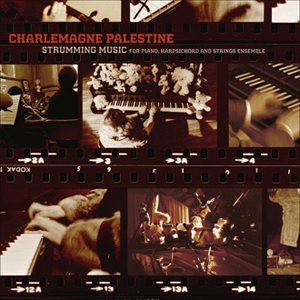Charlemagne Palestine's most contemporary music work.
These unpublished pieces are build on the same principle with other instruments of what he discovered on piano with Strumming mid-70. This is an unique variation of the way to compose.
A perpetual rise in a continuum of sound.
“All of the Strumming Music manifestations seem to have originated from Charlemagne's physical relationship with the colossal carillon bells in the tower of St. Thomas Church on Fifth Avenue in New York.
I met Charlemagne Palestine in 1968. The intensity of his listening impressed me as the intensity of his playing would later, when I heard him play on the carillon and the bells to "his church". I realized later, when Charlemagne had started to develop his series of piano pieces called Strumming, that he was assaulting that concrete ceiling and literally pushing through its three feet to release the sonic energy in the piano, much as he had with the carillon. Charlemagne's interest and work in electronic music increased in the late 60's and in 1970 he decamped to southern California where he became a graduate student working with Morton Subotnick. It was during this year at CalArts (1970-71) that Charlemagne developed an approach to the piano that was not only extremely repetitive and physical but predicated on the theory that, given the right stimulus, the instrument had a voice of its own and could produce a whole array of high overtones that seem to jump out on their own as if by magic. Over the next few years he developed and polished the music that came to be known simply as "Strumming."
The rapid alternation between single notes and chords and different registers became a technique that he seemed to own, and it really only worked with this magic piano. "Strumming" was the physical technique; the melodies and harmonies that resulted made the music breathe and feel alive. After a while, the ear doesn't distinguish between notes that are sounded by hammers and those which are harmonics, generated by the natural resonance of the piano and just appear because of the acoustical situation.”
Ingram Marshall
Charlemagne Palestine (born Charles Martin ni 1947 in Brooklyn, New York) wrote intense, ritualistic music in the 1970s, intended by the composer to rub against audiences' expectations of what is beautiful and meaningful in music. A composer-performer, he always performed his own works as soloist. His earliest works were compositions for carillon and electronic drones, and he is best known for his intensely performed piano works. He also performs as a vocalist. Palestine's performance style is ritualistic; he generally surrounds himself (and his piano) with stuffed animals, smokes large numbers of kretek (Indonesian clove cigarettes) and drinks cognac.
See also
Marie Canet: Palestine, first name Charlemagne – Meshugga Land.

